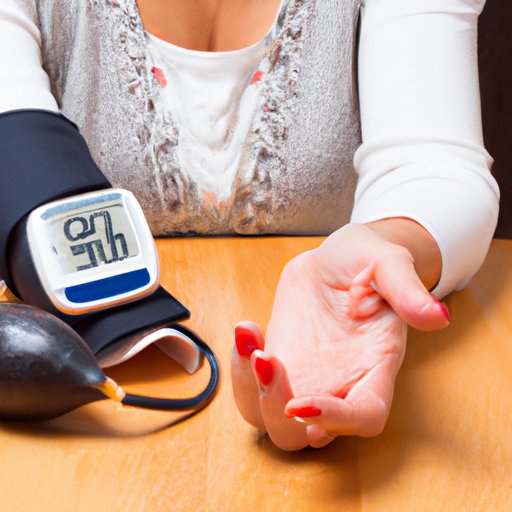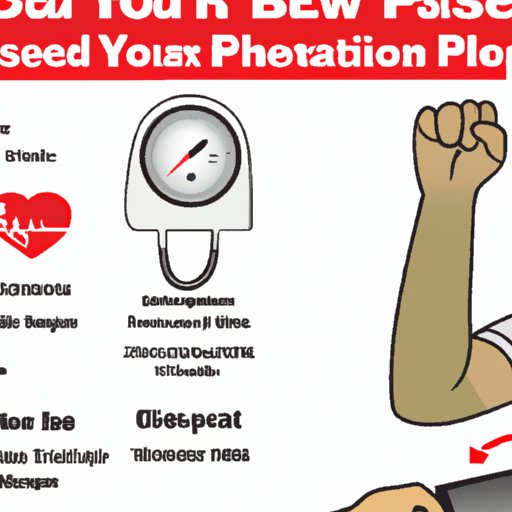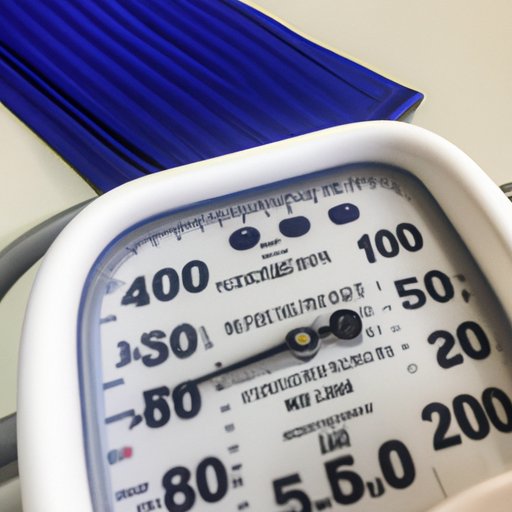Introduction
High blood pressure is a common medical issue that can lead to serious health complications if not managed properly. Monitoring your blood pressure regularly is important for managing the condition, but it’s also important to know when and how often to do so. One key factor to consider is how long after eating you should wait before checking your blood pressure.

Identifying the Optimal Time to Check Blood Pressure After Eating
When it comes to checking your blood pressure, there are several factors that can affect the accuracy of the results. For instance, certain foods and beverages can temporarily raise your blood pressure, while physical activity can also have an impact. As such, it’s important to consider these factors when determining when to check your blood pressure.
In general, the American Heart Association (AHA) recommends waiting at least 30 minutes after eating or drinking before taking your blood pressure. This is because the body needs time to process these substances and return to its normal resting state. Additionally, it’s important to avoid any strenuous activities during this time as they can further elevate your blood pressure.

A Guide to Checking Blood Pressure Following a Meal
Measuring your blood pressure both before and after eating is a good way to gauge how different foods and drinks may be affecting it. To do this, take your blood pressure first thing in the morning before you eat or drink anything. Then, measure it again 30 minutes after your meal. This will give you a better idea of how your diet is influencing your blood pressure reading.
It’s also important to note that post-meal blood pressure monitoring is not always effective. In some cases, the changes in your blood pressure may be too slight to detect. You may also need multiple readings over a longer period of time to get an accurate picture of how your diet is affecting your blood pressure.

The Benefits of Waiting Before Measuring Blood Pressure
Waiting before measuring your blood pressure has several benefits. For one, it allows you to accurately monitor your blood sugar levels and other health conditions. Additionally, it helps you understand the relationship between diet and blood pressure. By waiting before measuring your blood pressure, you can get a more accurate idea of how specific foods and drinks are impacting your overall health.
What You Need to Know About Post-Meal Blood Pressure Monitoring
When it comes to post-meal blood pressure monitoring, there are a few things to keep in mind. For people with high blood pressure, it’s important to monitor your blood pressure more often throughout the day. Additionally, it’s important to use the same arm and technique each time you measure your blood pressure to ensure accuracy.
Finally, it’s important to be aware of the effect that different foods and drinks can have on your blood pressure. Some foods and drinks, such as caffeine, can cause your blood pressure to temporarily spike. Therefore, it’s important to wait until your body has had time to process these substances before taking your blood pressure.
How Long Should You Wait Before Measuring Your Blood Pressure?
When it comes to determining how long you should wait before measuring your blood pressure, it depends on several factors. The type of food or drink you consume can have an effect on how quickly your body processes it, which in turn affects your blood pressure readings. Additionally, some people may experience a greater change in their blood pressure than others.
To get an accurate picture of how your diet is affecting your blood pressure, it’s best to wait at least 30 minutes after eating or drinking before taking your blood pressure. This gives your body enough time to process the substances and return to its normal resting state.
Exploring the Relationship Between Diet and Blood Pressure Measurements
It’s important to understand the relationship between diet and blood pressure measurements. Certain dietary habits, such as consuming lots of processed foods and sugary drinks, can increase your risk of high blood pressure. On the other hand, following a healthy diet rich in fruits, vegetables, and whole grains can help lower your blood pressure.
Additionally, making changes to your diet can have an immediate effect on your blood pressure. For example, reducing your sodium intake can help lower your blood pressure within a few days. Similarly, increasing your intake of potassium-rich foods can also help reduce your blood pressure.
Conclusion
Monitoring your blood pressure regularly is an important part of managing your overall health. However, it’s important to know when and how often to do so. In general, the AHA recommends waiting at least 30 minutes after eating or drinking before taking your blood pressure. This allows your body enough time to process these substances and return to its normal resting state. Additionally, understanding the relationship between diet and blood pressure can help you make informed decisions about your health.
By understanding how long after eating you should wait before checking your blood pressure, you can ensure that you’re getting an accurate reading. This can help you better manage your blood pressure and make informed decisions about your diet and lifestyle.
Summary of Key Points
• Wait at least 30 minutes after eating or drinking before taking your blood pressure.
• Certain foods and drinks can temporarily raise your blood pressure.
• Taking your blood pressure both before and after eating can help you gauge how different foods and drinks may be affecting it.
• Making changes to your diet can have an immediate effect on your blood pressure.
• Understanding the relationship between diet and blood pressure can help you make informed decisions about your health.
Recommendations for Further Reading
For more information about how long after eating you should wait before checking your blood pressure, the following resources can provide additional insight:
- American Heart Association: What Affects Blood Pressure
- Mayo Clinic: High Blood Pressure: Lifestyle and Home Remedies
-
(Note: Is this article not meeting your expectations? Do you have knowledge or insights to share? Unlock new opportunities and expand your reach by joining our authors team. Click Registration to join us and share your expertise with our readers.)
